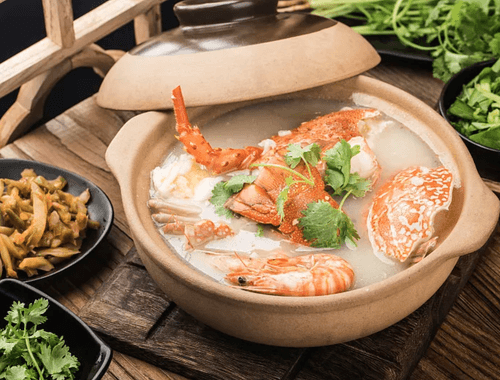
The Essence of Daily Life – Rice, Noodles, and Sweets
Chaoshan cuisine is woven into the fabric of daily life. This final chapter explores how the region transforms humble rice and flour into masterpieces of street food and comfort food, reflecting the warmth and ingenuity of its people.
Clay Pot Congee (Sha Guo Zhou)
The Technique: The "Live Roll" (Sheng Gun)
Chaoshan congee is not pre-cooked porridge. It uses the "Sheng Gun" (live roll) technique: raw or partially cooked rice is added to boiling supreme stock over intense heat, and rapidly stirred until the rice grains "bloom" but remain intact.
The Ingredient Integration: Seafood Infusion
The magic is the instant infusion. Ingredients—fresh crab, shrimp, or eel—are added raw and cooked directly in the boiling congee just before serving. This ensures the full flavour of the seafood is locked into the broth and rice.
Cultural Status: The Sha Guo Zhou is the icon of Chaoshan’s late-night culinary culture, offering supreme comfort and nourishment.
Chaoshan Rice Roll (Chao Shi Chang Fen)
The Technique: Paper-Thin Batter
A thin, silky layer of rice batter is steamed with fillings (shrimp, egg, preserved radish), then rolled.
The Defining Feature: The Unique Mixed Sauce
Unlike the lighter, sweeter soy sauce of Cantonese Chang Fen, the Chaoshan version is defined by its unique mixed sauce. This thick, savory glaze often blends peanut butter, Sha Cha (savay-salty-spicy) paste, and braising liquid, creating a highly flavourful and rich coating. It’s a full-flavour breakfast or snack.
Beef Kway Teow Soup (Niurou Guo Tiao Tang)
The Ingredient Philosophy: The dish stars Guo Tiao (a smooth, flat rice noodle) and the hyper-fresh sliced beef and handmade beef balls from the hot pot tradition.
The Cooking Method: The Clear Broth Infusion
The key is the clear, sweet beef bone broth and the preparation order. Guo Tiao, raw beef slices, and beef balls are placed in a bowl, and then piping hot broth is poured over them to flash-cook the beef to a perfect, blush pink color. The result is a clean, comforting bowl that is a daily staple.
Chaoshan Rice Cakes (Guo Pin): The Miniature Art of Rice
The Heritage: Ritual and Festival Food
Guo Pin are traditional rice-based snacks essential for festivals and rituals (e.g., the Red Peach Guo symbolizes longevity). They represent the Chaoshan belief in "eating in accordance with the seasons."
The Technique: The Carved Mold
The dumplings are filled (with savory or sweet fillings), and then pressed into beautifully carved wooden molds (known as Guo Yin), which are miniature works of art. This tradition showcases the Chaoshan characteristic of being "as delicate as embroidery" in their food preparation.
Pig Intestine Stuffed with Glutinous Rice (Zhu Chang Zhang Nuo Mi)
The Technique: The Patience of Craftsmanship
This is a labour-intensive, traditional snack. Glutinous rice, pork, mushrooms, and spices are mixed and carefully stuffed into cleaned pig intestine casing. It is then steamed and sliced.
The Texture and Flavor: The dish combines the chewy, savory casing with the soft, rich, aromatic rice filling. It embodies the rural ingenuity of Chaoshan people to utilize every part of their ingredients.
Chaoshan Sweet Glutinous Rice Dumplings (Yamu Nian)
The Local Specialty: The name Yamu Nian literally translates to "Duck Mother," referring to the small, round rice flour dumplings floating in the soup, resembling white duck eggs or a mother duck.
The Technique: This popular dessert soup features sweet rice dumplings with various fillings (sesame, taro, red bean), served in a fragrant sweet broth often complemented by toppings like gingko nuts, white fungus, and lotus seeds.
Culture: It is the essential sweet ending for family gatherings and celebrations, symbolizing completeness and good fortune.


